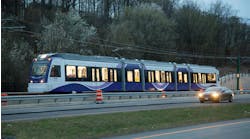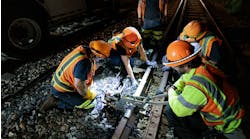Hampton Roads Transit (HRT), which serves six cities in southeastern Virginia, wants to prepare for population growth by building a 21st century transit system. The population in the region, known as Hampton Roads, is projected to grow to nearly two million by 2040 according to the U.S. Census Bureau. The envisioned transit system will serve all localities and connect the entire region.
HRT's light rail, “The Tide,” in Norfolk, Virginia, currently connects Eastern Virginia Medical School, downtown Norfolk, Norfolk State University, and ends at Newtown Road at the Norfolk-Virginia Beach boundary line. It is served by 11 stations and has four free park-and-ride lots. Service began on August 19, 2011, making it the first light rail system in Virginia.
In May 2015, the Virginia Beach City Council and HRT selected a preferred route for the first extension of the 7.4-mile starter line. It will continue the light rail from Newtown Road in Norfolk to Town Center in Virginia Beach. The selection was made based on the results of a multi-year study that compared a range of alternatives.
A year later the study is finished and 30 percent engineering effort is projected to be completed in the fall of 2016. The project is a partnership between the city of Virginia Beach, HRT and Virginia Department of Rail and Transportation. It will be funded entirely by the city of Virginia Beach and the Commonwealth of Virginia. The city of Virginia Beach will manage the request for proposal and design-build contract. The city anticipates selecting a design-build contractor in May 2017.
The city of Virginia Beach is the largest city in the commonwealth. This extension would end at the heart of its central business district. The 3.4-mile extension will include three additional stations and one park-and-ride at the new Town Center Station.
“We are really excited this extension will connect 35,000 people in the business district of Norfolk to approximately 20,000 people in the business district of Virginia Beach,” said William E. Harrell, president and CEO of HRT. “It will increase connectivity and mobility options while also supporting Virginia Beach’s plan to focus new growth in a dense, mixed-use corridor. We are waiting final approval from the Virginia Beach City council.”
The extension includes two long span bridges, each approximately 200 feet in length, and three traction power sub-stations. The double track that exists will continue along the former Norfolk Southern (NS) Railway, which was purchased by the city in 2010. New light rail vehicles will be purchased along with a new signal system.
There are many expected challenges with any transit extension. This project will involve major utility modifications for Virginia Beach to include the relocation of overhead electric power lines and major water supply lines for Virginia Beach. The extension involves seven set grade and two major arterial roadway crossings. The design of the project must consider the sequence by which structures are erected; vehicular traffic in the general-purpose lanes may not be hindered. Additionally, maintaining revenue service on the existing line must be maintained during construction.
The city of Virginia Beach has ambitious plans to develop an east-west shared-use pathway parallel to the tracks. The idea is to transform an abandoned Norfolk Southern railroad track into a bike and pedestrian-friendly community asset. The city of Virginia Beach brought a delegation to Charlotte, North Carolina. They were impressed with the design of its shared-use pathway and used it as a case study for the development of their own.
This project would be constructed in concert with the light rail extension and would enhance citizen mobility and likely be a catalyst for development along the transit corridor. Virginia Beach anticipates it will be an enhancement to the surrounding community and serve as an amenity to the residents and visitors of the city.
The city conducted an economic analysis for transit-oriented development and found, Virginia Beach would gain “roughly $323 million in new real estate taxes alone over the next 30 years, plus about $14 million in new business taxes.” The study details how hundreds of acres around the stations will redevelop if light rail is built — resulting in new jobs and businesses locating to Virginia Beach. This would include new offices, hotels, stores, restaurants and condos.
The city of Virginia Beach anticipates future development of light rail all the way to the oceanfront with lines extending to the north and south to provide service to other parts of the city.
Alisa Crider is public relations & social media coordinator for Hampton Roads Transit.


